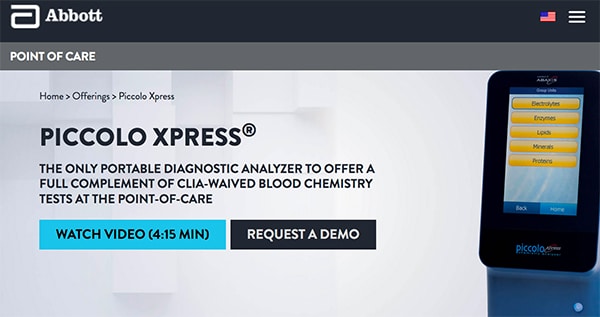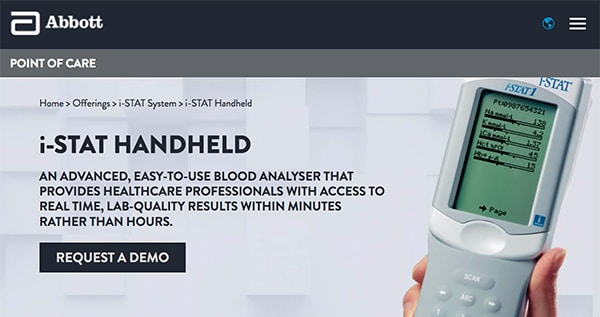In the past 12 months, what new concerns are customers and potential customers raising?
Greiner (Roche): A big one is continued access in low-volume, rural areas. Customers want to have the same menu as their midsize and large counterparts, such as the procalcitonin assay for sepsis management, as well the troponin Gen 5 assay. These assays have big impact in terms of cost, outcomes, and many other key metrics by which institutions large and small measure their successes. Small-volume rural labs want reassurance they’re going to have the same menu as their counterparts at the core or reference lab. And in this era of integration and consolidation, it’s smart to be scaled for change. Access ensures that game-changing tests aren’t reserved for high-volume settings. Everyone deserves the best care possible.
Brinster (MedTest): The new trend is increased drugs-of-abuse testing. Many of our clients have an opioid task force, and some are also associated with a behavioral health center where they’re looking at how to provide their community with the best and most efficient screening and confirmational testing. This has thrown a new set of requirements onto the laboratory, and they’ve been coming to us for help because it’s an area of expertise for MedTest.
Ishii (Beckman Coulter): The modern laboratory is under increasing pressure to produce fast, accurate results while reducing costs. As a manufacturer we continue to seek solutions that will meet volume demands, produce precise results, and lower costs. Many of these solutions involve offering reliable systems characterized by scalable throughput, maximized uptime, and efficient reagent and energy use.
Cost concerns are always with us. What new approaches to cost and value do you see from customers and wish to pursue as a corporate matter?
Greiner (Roche): One is encouraging laboratory professionals to have long-term vision, to create and build that solution in the laboratory that’s going to be sustainable for the future. The second is the laboratory management team being able to articulate to its leadership and stakeholders the value the lab provides far beyond its walls. For example, the lab plays a huge role in readmission rates, improving the standard of care, reducing costs, and patient satisfaction.
It’s also important for labs to take that long-term view so they are consolidation and integration ready. That’s where that standardization piece becomes critical—you have to know, when you’re bringing all of these different labs together in an integrated health network, that it’s apples to apples.
Brinster (MedTest): As a relatively small company, we can be more flexible if an account needs us to write a deal that’s a little different from what’s normally offered. We make sure we’re within regulations, but we work with the customer to make agreements as efficient and cost-effective as possible.
Bullen (Nova): From a buying perspective, we’ve seen hospitals in the past several years go from buying as a single institution to integrated hospital networks and/or group purchasing organizations. Nova goes through great effort to ensure that we’re affording every hospital the best diagnostic results at a good price. This can be a big challenge.
[hr]
Tosoh asked that the listing for its AIA 360 immunoassay analyzer be removed from the following product guide because the company’s regulatory review could not be completed by CAP TODAY’s deadline.
Simpler and condensed
For the first time, CAP TODAY has combined its chemistry and immunoassay analyzer product guides rather than publish them separately. And we have done so in two easy-to-navigate listings: one for the low-volume and point-of-care markets (in this issue) and another for mid- to high-volume laboratories (to be published in the July issue). Each of the two listings profiles chemistry and immunoassay analyzers as well as analyzers that perform both functions.
“Users needed something simpler and condensed,” says CAP TODAY publisher Bob McGonnagle. “The guides are a first step in seeing what is available. The commitment to a system is usually intended to serve the widest possible array of testing sites within a hospital system, with a uniformity of vendor, instrumentation, and method. It’s in that spirit that we decided to revamp the chemistry and immunoassay product guides for 2018.”
The revised product guides feature about the same number of companies as in the past but in fewer pages. “Since there are so many chemistry and immunoassay analyzers on the market, we asked companies to give us from each family of analyzers they market the one analyzer they would most like to highlight,” says Kim Carey, CAP TODAY managing editor. In some instances, companies provided in their listings the names of other models in the same analyzer family.
Each company decided on its own whether to list its analyzers in the point-of-care/low-volume guide or in the mid- to high-volume guide. “They determined the best fit for their analyzer,” Carey says.
CAP TODAY thanks the following experts for their guidance in the revision of the guides: David Alter, MD, DABCC, clinical/chemical pathologist, Spectrum Health Regional Laboratory, and clinical professor of pathology, Michigan State University College of Human Medicine; Frederick L. Kiechle, MD, consultant, clinical pathology, Cooper City, Fla.; Maria Crisostomo, senior sales product manager, Bio-Rad Laboratories; and Edward Gilligan, technical marketing manager, Roche Diagnostics.
We invite readers and the companies to share their thoughts about the following product guide by telling us what works and what can be improved. Send comments to Kristen Eberhard at keberha@cap.org.
Readers interested in a particular analyzer should confirm it has the stated features and capabilities. —Amy Carpenter Aquino
 CAP TODAY Pathology/Laboratory Medicine/Laboratory Management
CAP TODAY Pathology/Laboratory Medicine/Laboratory Management


